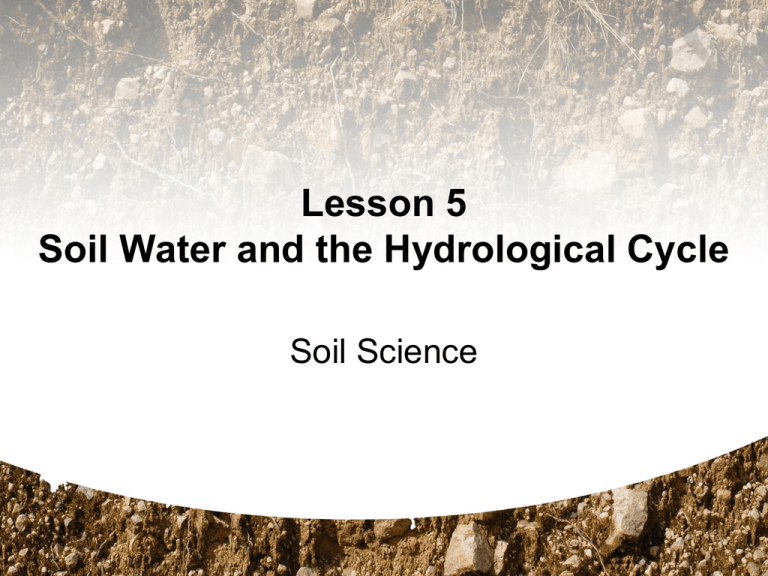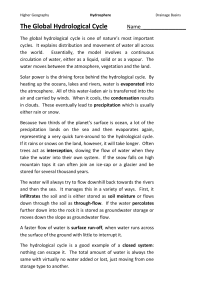Lesson 5
advertisement

Lesson 5 Soil Water and the Hydrological Cycle Soil Science 土壤水(Soil Water) • 土壤水分之重要性: 1. 水分為植物生長所必需 1. 原生質之組成 2. 光合作用所需 3. 維持膨壓 2. 水可作為溶劑(solvent),影響營養元素或其 他溶質(如重金屬、農藥)在土壤中之動態 3. 影響土壤之通氣性 土壤水分含量(Water Content) • Gravimetric water content(質量比例) – θg = 水之質量 乾土之質量 Mw Ms • Volumetric water content(體積比例) 水之體積 – θv = 乾土之體積 • ρw = 1 →θg = Vw V 1 Bd θv Question ? θ=5% 砂土 ? θ=10% 粘土 水分之移動 何者之水分植物較易利用? 土壤水之能量狀態(Energy Status) Water potential (勢能) ψ= μw (soil)- μ。w (standard state)=RT ln e/e。 μw:chemical potential (free energy/ mole) of water e/e。:ratio of vapor pressure of water in the soil to vapor pressure of water in the standard state R:gas constant T:absolute temperature (。K) 土壤水之能量狀態 (Energy Status) (續) 定義標準狀況(standard state)為 Pure water (純的,無溶質存在) Free water (除了重力之外,沒有外力之作用) at To, Po (temp. and pressure are arbitrary) and Zo (reference elevation) →water potential ψ=0 土壤水之能量狀態 (Energy Status) (續) Water potential單位: energy/mole (J/mole) 也可表為 energy/volume (J/m3) ∵J = N (force) × m → J/m3 = N/m2 N/m2為壓力之單位→water potential可以壓力單位表之 如bar (=105 N/m2);或者以導水頭(hydraulic head)表之, 因壓力可以靜水壓表示 靜水壓p=ρgh ρ:水密度 g:重力加速度 h:水柱高(head) pF= log h 通常用來表示water potential (h:cm) 土壤水之能量狀態 (Energy Status) (續) Ψ = ψm + ψs + ψp + ψg • Matric potential (基質勢能,ψm): – 由於土壤基質毛細力及吸附力所產生,這些力 吸附及結合水分於土壤中,降低其勢能使之低 於自由水 ψm≦0 • Solute potential(滲透勢能,ψs): – 土壤水分中有溶質存在影嚮其熱力學性質並降 低其勢能 ψs≦0 土壤水之能量狀態 (Energy Status) (續) Ψ = ψm + ψs + ψp + ψg • Pressure potential(壓力勢能,ψp): – 土壤水分承受比大氣壓力更大之壓力,而得之 正壓力 ψp≧0 • Gravitational potential(重力勢能,ψg) Measuring Soil Water Content • Water content – Destructive sampling: • Oven-dried method – Undestructive sampling: • Neutron Probe method • γ-ray attenuation method • Gypsum block (electrical resistance block) method Measuring Soil Water Potential • Tensiometer • Gypsum block method • Thermocouple psychrometer Tensiometer (a) vacuum gauge tensiometer (b) mercury manometer tensiometer • Diagram of a tensiometer, measuring energy state of soil water with (a) a vacuum gauge and (b) a mercury manometer 濕度計(Psychrometer) • 乾濕球溫度差 • Thermocouple Psychrometer 土壤水分特性曲線 (Moisture Characteristic Curve) Field capacity (田間容水量) • 田間土壤水分飽和後二至三日,自然排水(free drainage)停止,此時土壤中所含水分之百分數 ψ pF 2.54,-1/3bar時,土壤所含水分之百分數。 • Wilting point (凋萎係數) – 植物開始凋萎時土壤所含水分之百分數 ψ pF4.2, -15bar時,土壤所含水分之百分數。 • Available water (有效水分含量) – 田間容水量-凋萎係數 (即-1/3bar~-15bar間之水分) • e.g. 凋萎係數(%) 有效水量(%) Clay loam soil 7.1 13.1 Quartz sand 0.57 0.83 Water Movement in Saturated Soil • 水分在土壤中之移動 – 高勢能 低勢能 • 水在飽和狀態時之移動 (e.g.水田土壤) • Darcy’s law Q K (H L) KH q A • • • • • L 1 L Q:單位時間流經土柱之體積 A:土柱橫切面積 H:水力頭降落(Hydraulic head drop) L:土柱長度 q = :單位時間通過單位橫切面積水分之 體積或稱流束(flux) • k:水力傳導度(hydraulic conductivity) Water Movement in Saturated Soil (續) • ks (saturated hydraulic conductivity) – 飽和水力傳導度 – sand:10-2~10-3 cm/sec – clay:10-4~10-7 cm/sec Water Movement in Unsaturated Soil • 水在不飽和狀態之移動 – 低引力 高引力 • 移動方向:濕→潤→乾 q K H L • dH K dH dZ (Hydraulic gradient; 水力梯度) : 水流動 之推進力(driving force) dm dm dZ • 飽和狀態 H = P+Z q K K 1 dZ dZ • 不飽和狀態 H = m+Z dZ The Soil and the Hydrological Cycle (水文循環) The soil and the plants and animals it supports play key roles in helping to moderate the adverse effects of excesses and deficiencies of water. The soil serves as a massive reservoir to take in water during times of surplus and the release it in due time, either to satisfy the transpiration requirements of plants or to replenish groundwater that moves slowly into nearby streams or that replenishes even deeper reservoirs under the earth. The soil is also used as a recipient of animal, domestic, and industrial wastewaters that are later carried downward through the soil and through drainage channels to rivers and lakes downstream. The flow of water through the soil thereby connects the chemical pollution of soils to the groundwater. The Soil and the Hydrological Cycle (水文循環) • • • • • • Precipitation(降雨) Irrigation(灌溉) Infiltration(滲濾):水由土表流入土壤中 Runoff(逕流):水在地表上流動 Evaporation(蒸散):水以蒸氣形式自地表損失至大氣中 Transpiration(發散):水以蒸氣形式自植物葉的表面損失 至大氣中 • Percolation(滲漏):水在土壤剖面中向下流動 • Drainage(排水) • 土壤性質影響了上述各個process,因而在水文循環中扮 演重要之角色。 Infiltration vs. Runoff • Infiltration rate < precipitation intensity →Runoff occurs → Soil erosion • 影響Infiltration之主要土壤性質:土壤質地與土壤構造 Evapotranspiration • 影響Evapotranspiration之因子: – – – – – – Radiant energy Atmospheric vapor pressure (Relative humidity) Temperature Wind Soil moisture supply Plant characteristics • Evapotranspiration之控制 – – – – – Plant characteristics and management Fallow Cropping Mulches Paper and plastic mulches Crop residue and conservation tillage Percolation and Groundwater • Percolation and groundwater movement of chemical in the drainage water 1. A depletion of plant nutrients from the soil and from the root environment of plants 2. The accumulation of chemical nutrients in ponds, lakes, reservoirs, and groundwater downstream→Eutrophication(優養化) 3. The groundwater is charged with synthetic chemicals and transports them to downstream bodies of water. Supplies and Outflow of Soil Water • Human enhancement of supplies and outflow of soil water – Artificial drainage – Irrigation








